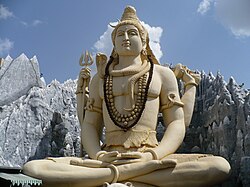Hare Krsna
Please accept my humble obeisance. All glories to Srila Prabhupada
yoga-isvara-isvarah — the master of all masters of yoga- Krishna
(the source of all mystic powers)
Great Master of yoga Lord Shiva
There are many different types of yoga. Yoga means the system, and yogi means the person who practices that system. Yoga is mystic power
Krsna is called Yogesvarah (Yoga Iswara) the source of all mystic powers and Lord Siva is called Yogisvara (Yogi Iswara). So it is to be understood that Krsna is the Master of the system andShiva is the master in practicing that system.
Lord Siva is called yogisvara, the master of all yogis, and Krsna is also called yogesvara. Yogisvara indicates that no one can surpass the yoga practice of Lord Siva, and yogesvara indicates that no one can surpass the yogic perfection of Krsna.
>>> Ref. VedaBase => SB 4.6.38
So Krsna is describing personally. Krsna's name is Yogesvara, and Lord Siva's name is Yogisvara.
>>> Ref. VedaBase => Bhagavad-gita 7.1 -- San Francisco, March 26, 1968
Taraka Mudra

Siddhasana
Lord Siva's symptoms of austerity are not exactly those of a Vaisnava. Lord Siva is certainly the number one Vaisnava, but he exhibits a feature for a particular class of men who cannot follow the Vaisnava principles. The Saivites, the devotees of Lord Siva, generally dress like Lord Siva, and sometimes they indulge in smoking and taking intoxicants. Such practices are never accepted by the followers of Vaisnava rituals.
>>> Ref. VedaBase => SB 4.6.36
Lord Siva is full of wisdom and tapasya, austerity. One who knows the modes of work is understood to be situated on the path of devotional service to the Supreme Personality of Godhead. One cannot serve the Supreme Personality of Godhead unless one has achieved full perfectional knowledge in the ways and means of performing devotional service.
Lord Siva is described here as adhisvara. Isvara means "controller," and adhisvara means particularly "controller of the senses." Generally our materially contaminated senses are apt to engage in sense gratificatory activities, but when a person is elevated by wisdom and austerity, the senses then become purified, and they become engaged in the service of the Supreme Personality of Godhead. Lord Siva is the emblem of such perfection, and therefore in the scriptures it is said, vaisnavanam yatha sambhuh: Lord Siva is a Vaisnava. Lord Siva, by his actions within this material world, teaches all conditioned souls how to engage in devotional service twenty-four hours a day. Therefore he is described here as loka-mangala, good fortune personified for all conditioned souls.
>>> Ref. VedaBase => SB 4.6.35
The lord was sitting on a mattress of straw because such a sitting place is accepted by persons who are practicing austerities to gain understanding of the Absolute Truth. In this verse it is specifically mentioned that he was speaking to the great sage Narada, a celebrated devotee. Narada was asking Lord Siva about devotional service, and Siva, being the topmost Vaisnava, was instructing him. In other words, Lord Siva and Narada were discussing the knowledge of the Veda, but it is to be understood that the subject matter was devotional service. Another point in this connection is that Lord Siva is the supreme instructor and the great sage Narada is the supreme audience. Therefore, the supreme subject matter of Vedic knowledge is bhakti, or devotional service.
The sitting posture described herein is called virasana according to the system of astanga-yoga performances. In the performance of yoga there are eight divisions, such as yama and niyama -- controlling, following the rules and regulations, then practicing the sitting postures, etc. Besides virasana there are other sitting postures, such as padmasana and siddhasana. Practice of these asanas without elevating oneself to the position of realizing the Supersoul, Visnu, is not the perfectional stage of yoga. Lord Siva is called yogisvara, the master of all yogis, and Krsna is also called yogesvara. Yogisvara indicates that no one can surpass the yoga practice of Lord Siva, and yogesvara indicates that no one can surpass the yogic perfection of Krsna. Another significant word is tarka-mudra. This indicates that the fingers are opened and the second finger is raised, along with the arm, to impress the audience with some subject matter. This is actually a symbolic representation.
>>> Ref. VedaBase => SB 4.6.38

Shiva meditates on Krsna and Krsna meditates on the gopis.
Note:
In Brihat Bhagavatamrita sanatana goswami says "gopis are superior to the masters of yoga".
Comments